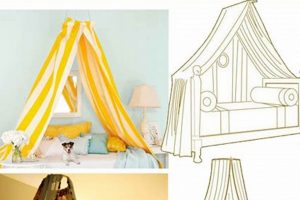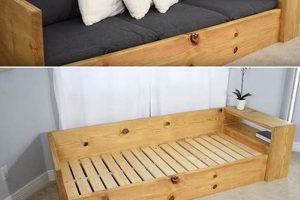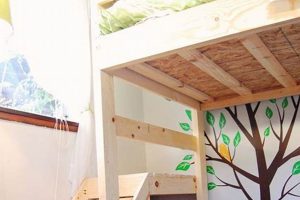The construction of a suspended outdoor lounging platform, commonly configured from repurposed bedding components, provides an alternative seating arrangement for verandas or patios. These structures typically involve suspending a mattress or cushioned frame from a porch ceiling or similarly robust overhead support. The resulting installation functions as an expansive, swinging seat, offering enhanced relaxation in an outdoor setting.
Such constructions offer several advantages, including cost-effectiveness when utilizing reclaimed materials, customizable dimensions to suit specific spaces, and the potential for enhanced comfort compared to traditional porch swings. Historically, suspended seating has been a prevalent feature in residential architecture, evolving from simple hammocks to more elaborate, furniture-integrated swing designs. The utilization of mattress components represents a modern adaptation, maximizing comfort and space efficiency.
The following sections will detail key considerations for creating a safe and structurally sound outdoor lounging platform, encompassing aspects of material selection, suspension techniques, and weatherproofing strategies to ensure longevity and user satisfaction.
Essential Construction Guidance
The successful assembly and implementation of a safe and comfortable outdoor lounging platform requires careful planning and execution. Adherence to the following guidelines will contribute to a secure and enjoyable end result.
Tip 1: Structural Integrity is Paramount: Prioritize the load-bearing capacity of the porch or overhead structure. Consult with a structural engineer or qualified contractor to ensure the support system can safely accommodate the weight of the platform and its occupants. Reinforce existing structures as needed.
Tip 2: Material Selection for Longevity: Opt for weather-resistant materials suitable for outdoor exposure. Treated lumber, galvanized steel, and marine-grade ropes offer superior durability against moisture, UV radiation, and temperature fluctuations. Regularly inspect and maintain these materials to prevent degradation.
Tip 3: Suspension System Considerations: Employ heavy-duty chains or ropes with a high tensile strength. Ensure that the suspension points are evenly distributed to balance the weight distribution and prevent uneven stress on the structure. Regularly inspect suspension components for wear and tear.
Tip 4: Secure Attachment Mechanisms: Utilize appropriate hardware, such as eye bolts and quick links, rated for the intended load. Confirm that all connections are securely fastened and properly sized to prevent slippage or breakage. Implement locking mechanisms to prevent accidental disconnections.
Tip 5: Weather Protection Measures: Consider incorporating a waterproof cover or awning to protect the platform from rain and direct sunlight. Regularly clean and treat the materials to prevent mold and mildew growth. Proper drainage solutions will prevent water accumulation and material damage.
Tip 6: Comfort Enhancement: Incorporate cushions and padding made from weather-resistant materials. Consider using fabrics that are UV-resistant and easy to clean. Add throw pillows and blankets for increased comfort and aesthetic appeal.
Tip 7: Safety Features Implementation: Install safety chains or barriers to prevent accidental falls. Ensure adequate clearance around the platform to prevent collisions with surrounding objects. Regularly inspect the platform for potential hazards.
By adhering to these guidelines, a safe, durable, and comfortable outdoor lounging space can be successfully constructed. Careful attention to structural integrity, material selection, and safety features are crucial for long-term enjoyment and peace of mind.
The subsequent sections will focus on design inspiration and aesthetic considerations for customizing the lounging platform to individual preferences and architectural styles.
1. Structural Support Assessment
The creation of a suspended outdoor lounging platform necessitates a comprehensive structural support assessment. This evaluation determines the suitability of the existing porch or overhead framework to bear the added weight of the completed structure and its occupants. Failure to accurately assess the load-bearing capacity can lead to structural compromise, potentially resulting in collapse and subsequent injury. A primary cause of failure stems from underestimating the combined static and dynamic loads, including the weight of the platform itself, the weight of individuals using the platform, and any additional stress induced by swinging motions.
A professional structural engineer or qualified contractor can perform a detailed inspection, identifying any pre-existing weaknesses or deficiencies in the supporting structure. This assessment may involve evaluating the condition of posts, beams, and joists, as well as examining connection points and fastener integrity. Real-life examples of structural failures due to inadequate support are readily available, serving as cautionary tales for those undertaking such projects. For instance, a porch ceiling designed for light static loads may be unable to withstand the dynamic stress imposed by a swinging platform, leading to gradual degradation and eventual failure. The practical significance of this assessment lies in mitigating risks and ensuring the safety and longevity of the installation.
In conclusion, a meticulous structural support assessment is a non-negotiable prerequisite for any suspended outdoor lounging platform project. Ignoring this crucial step introduces significant safety hazards and potential property damage. Thorough evaluation by qualified professionals and subsequent reinforcement, if necessary, are essential for creating a secure and enjoyable outdoor relaxation space. The financial investment in a professional assessment is minimal compared to the potential costs associated with structural failure and injury.
2. Weather-Resistant Material Selection
Weather-resistant material selection is paramount in the construction of a suspended outdoor lounging platform, directly influencing the structure’s longevity, safety, and aesthetic appeal. Exposure to the elements necessitates careful consideration of material properties to prevent premature degradation and maintain structural integrity.
- Wood Durability and Treatment
Untreated wood is susceptible to rot, insect infestation, and warping when exposed to moisture and fluctuating temperatures. Pressure-treated lumber, specifically designed for outdoor use, offers resistance to these factors. Cedar and redwood are naturally decay-resistant options, though often more expensive. The choice of wood and its subsequent treatment significantly impacts the platform’s lifespan and maintenance requirements.
- Fabric and Cushion Considerations
Outdoor fabrics must withstand UV radiation, moisture, and potential staining. Acrylic fabrics, like Sunbrella, are engineered for outdoor use, offering resistance to fading and mildew. Cushions should be constructed with closed-cell foam or materials that prevent water absorption. Proper fabric and cushion selection ensures user comfort and minimizes the risk of material degradation over time.
- Metal Component Corrosion Resistance
Metal hardware, including chains, hooks, and bolts, are prone to corrosion if not properly treated. Galvanized steel or stainless steel provides superior corrosion resistance in outdoor environments. Regularly inspecting and maintaining metal components, including applying protective coatings, is essential to prevent structural failure.
- Rope and Suspension Cord Durability
Natural fiber ropes are susceptible to rot and weakening when exposed to moisture. Synthetic ropes, such as nylon or polyester, offer superior strength and resistance to environmental degradation. Rope selection should consider the weight-bearing capacity, UV resistance, and resistance to abrasion. Regular inspection and replacement of worn ropes are crucial for safety.
The integration of appropriate weather-resistant materials is not merely an aesthetic choice but a fundamental engineering consideration in the construction of a suspended outdoor lounging platform. Neglecting this aspect can lead to premature structural failure, necessitating costly repairs or complete replacement. Proper material selection ensures a safe, durable, and enjoyable outdoor relaxation space for years to come.
3. Secure Suspension Hardware
The structural integrity of a suspended outdoor lounging platform, often constructed utilizing repurposed bedding components, is inextricably linked to the selection and implementation of secure suspension hardware. This hardware forms the critical connection between the platform and its overhead support structure, bearing the entire load and ensuring user safety.
- Load-Rated Chains and Ropes
Chains or ropes employed in the suspension system must possess a sufficient load rating, exceeding the anticipated weight of the platform and its occupants. Underestimation of this load capacity poses a direct risk of catastrophic failure. Example: A chain rated for 500 lbs used to support a platform weighing 400 lbs with two occupants weighing 300 lbs collectively is inadequate, as it surpasses the rated limit. The selection process mandates adherence to engineering safety factors to account for dynamic loads and material fatigue.
- Appropriate Attachment Hardware (Eye Bolts, Quick Links)
Attachment hardware, such as eye bolts and quick links, must be of appropriate size and material grade to withstand the applied forces. Improperly sized or substandard hardware can deform, weaken, or fracture under load, leading to instability or complete detachment. Example: Using eye bolts not specifically designed for overhead lifting applications introduces a potential point of failure. Hardware selection should align with established engineering standards and manufacturer specifications.
- Correct Installation Techniques
Even high-quality suspension hardware can fail if improperly installed. Correct installation techniques, including proper drilling, anchoring, and tightening, are essential to ensure a secure connection. Example: Over-tightening an eye bolt can strip the threads or damage the surrounding support structure, compromising its holding power. Adherence to manufacturer instructions and recommended torque specifications is crucial.
- Regular Inspection and Maintenance
Suspension hardware is subject to wear and tear over time, particularly when exposed to outdoor elements. Regular inspection for signs of corrosion, deformation, or fatigue is necessary to identify and address potential problems before they escalate. Example: Rust formation on a chain link indicates a loss of material strength and necessitates replacement. A proactive maintenance schedule can significantly extend the lifespan of the suspension system and prevent unexpected failures.
The aforementioned facets highlight the critical role of secure suspension hardware in the successful and safe implementation of a suspended outdoor lounging platform. Compromising on the quality, selection, or installation of this hardware introduces unacceptable risks. A thorough understanding of load ratings, material properties, and proper installation techniques is paramount for ensuring the long-term structural integrity and safety of the platform.
4. Weight Distribution Management
Weight distribution management is a critical engineering consideration in the design and construction of a suspended outdoor lounging platform. The structural integrity and longevity of the platform, along with the safety of its occupants, are directly contingent upon ensuring an even distribution of weight across the supporting structure and suspension system. Uneven weight distribution creates stress concentrations, potentially leading to material fatigue, structural failure, and an increased risk of collapse. Consider a scenario where a platform, constructed from a repurposed bed frame, exhibits significant weight imbalance. If one side is consistently subjected to a higher load due to uneven weight distribution, the corresponding suspension components will experience accelerated wear and tear, increasing the likelihood of a catastrophic failure at that point. This highlights the practical significance of careful weight distribution management.
Effective weight distribution management encompasses several key strategies. First, the design of the platform itself should strive for symmetrical loading. This may involve strategically placing heavier components, such as the mattress or cushioning, to balance the overall weight. Second, the suspension points should be evenly spaced and appropriately rated to handle the anticipated load. Unevenly spaced suspension points will create varying stress levels on the supporting structure, potentially overloading certain areas. Third, the materials used in the platform’s construction should be selected and arranged to minimize localized stress concentrations. For example, reinforcing the corners of the platform can prevent cracking or deformation under load. The practical application of these strategies translates directly into a more durable, stable, and safer lounging platform.
In conclusion, weight distribution management is not a mere detail but a fundamental design principle in the construction of a suspended outdoor lounging platform. Neglecting this aspect introduces unacceptable risks to structural integrity and user safety. Implementing symmetrical design, strategically positioning suspension points, and employing durable materials are essential for achieving optimal weight distribution and ensuring a safe and enjoyable outdoor relaxation experience. Understanding the principles of weight distribution management transforms the construction process from a simple assembly of materials into a deliberate engineering endeavor, prioritizing safety and longevity above all else.
5. Comfort and Safety Integration
Comfort and safety represent interdependent elements within the design and construction of a suspended outdoor lounging platform. The pursuit of optimal comfort should not compromise structural integrity or user security. Conversely, overly stringent safety measures, if implemented without regard for ergonomic considerations, can diminish the intended relaxation experience. A direct relationship exists between these two factors; a poorly designed platform, while visually appealing, may present hidden hazards, while a structurally sound but uncomfortable platform fails to fulfill its primary function. A practical illustration lies in the selection of suspension hardware. While robust chains may provide ample load-bearing capacity, their exposed edges could pose a cutting hazard. Therefore, a balance must be struck, perhaps through the use of protective coverings or alternative suspension materials with rounded edges.
The integration of comfort and safety extends beyond material selection to encompass design considerations. For instance, the platform’s height above the ground should be carefully calibrated to minimize the risk of injury in the event of a fall, while still allowing for ease of access and egress. Similarly, the inclusion of railings or safety nets can enhance user security, particularly for platforms intended for use by children or individuals with mobility limitations. The practical application of these principles involves a meticulous assessment of potential hazards and a proactive implementation of mitigation strategies. This may necessitate consulting with engineering professionals to ensure compliance with relevant safety standards and building codes. A successful design prioritizes both structural soundness and user well-being, creating an outdoor relaxation space that is both inviting and secure.
In summary, comfort and safety integration is not an optional consideration, but rather a foundational requirement for any suspended outdoor lounging platform project. A comprehensive approach, encompassing material selection, design considerations, and adherence to safety regulations, is essential for creating a functional and enjoyable outdoor space that minimizes the risk of injury. Challenges in achieving this integration often arise from competing priorities and budget constraints; however, prioritizing user safety is paramount. Failure to do so can result in legal liabilities and, more importantly, compromised well-being. The ultimate goal is to create a harmonious blend of comfort and security, resulting in a relaxing and worry-free outdoor experience.
Frequently Asked Questions
The following addresses common inquiries regarding the construction and safety of suspended outdoor lounging platforms, often configured using repurposed bedding components. It aims to provide clear, informative answers to assist in informed decision-making.
Question 1: What is the minimum load-bearing capacity required for a porch to support a suspended lounging platform?
The minimum load-bearing capacity is dependent on the combined weight of the platform, its supporting structure, and the anticipated number of occupants. A structural engineer must assess the porchs existing capacity, accounting for both static and dynamic loads. Failure to meet or exceed this capacity poses a significant safety risk.
Question 2: What types of materials are best suited for outdoor platforms to withstand weather conditions?
Pressure-treated lumber, cedar, or redwood are recommended for the platform frame due to their resistance to decay. Outdoor-rated fabrics, such as acrylics, should be used for cushions and upholstery. Stainless steel or galvanized hardware is essential to prevent corrosion.
Question 3: How should the suspension system be designed to ensure even weight distribution and prevent stress on the structure?
The suspension system design should incorporate multiple suspension points, evenly spaced to distribute the weight across the platform. The angle of the suspension lines should be minimized to reduce lateral forces on the supporting structure. Load ratings of all components, including chains, ropes, and hardware, must be verified.
Question 4: What are the crucial safety measures that must be implemented in the construction of these platforms?
Safety measures include: a professional structural assessment, use of load-rated hardware, secure attachment methods, regular inspections for wear and tear, and the inclusion of safety chains or barriers to prevent falls. Adherence to local building codes is also paramount.
Question 5: What are the common mistakes to avoid during the construction of a suspended outdoor lounging platform?
Common mistakes include: underestimating the load-bearing capacity, using substandard materials, neglecting proper attachment techniques, failing to adequately protect the platform from weather, and neglecting regular maintenance.
Question 6: How can the longevity of the platform be extended and the risk of structural failure minimized?
Longevity and minimized risk are achieved through: periodic inspections of all structural components, prompt replacement of worn or damaged hardware, application of weather-resistant coatings, seasonal cleaning to prevent mold and mildew, and ensuring adequate drainage to prevent water accumulation.
Accurate assessment, careful material selection, and consistent maintenance are paramount to safety and longevity.
Subsequent sections will examine design considerations for customizing suspended outdoor lounging platforms.
Conclusion
The preceding discussion has delineated critical factors involved in the construction of a “diy bed porch swing.” These factors encompass structural integrity, material selection, suspension mechanics, weight distribution, and the integration of both comfort and safety considerations. Successful implementation of these elements ensures a durable, safe, and aesthetically pleasing outdoor relaxation platform.
Therefore, meticulous planning, adherence to engineering principles, and consistent maintenance are paramount. The decision to construct a “diy bed porch swing” necessitates a commitment to prioritizing safety and structural soundness above all else, ensuring long-term enjoyment and mitigating potential hazards.







